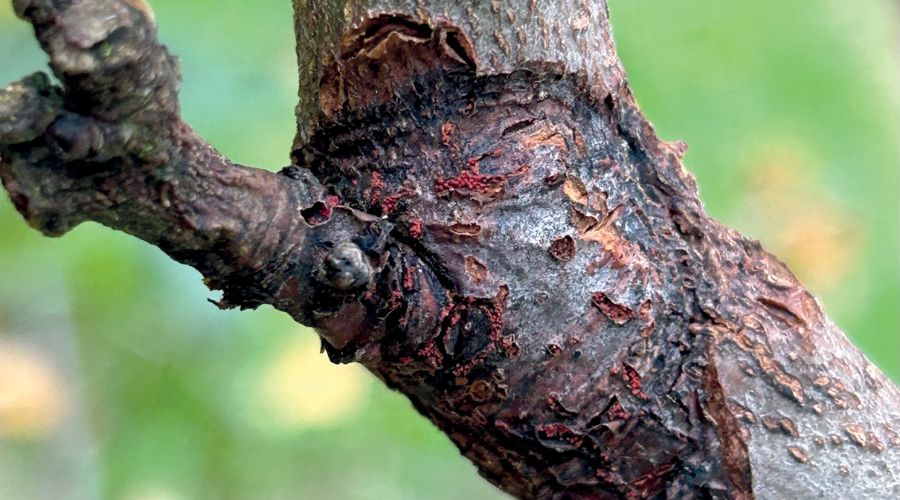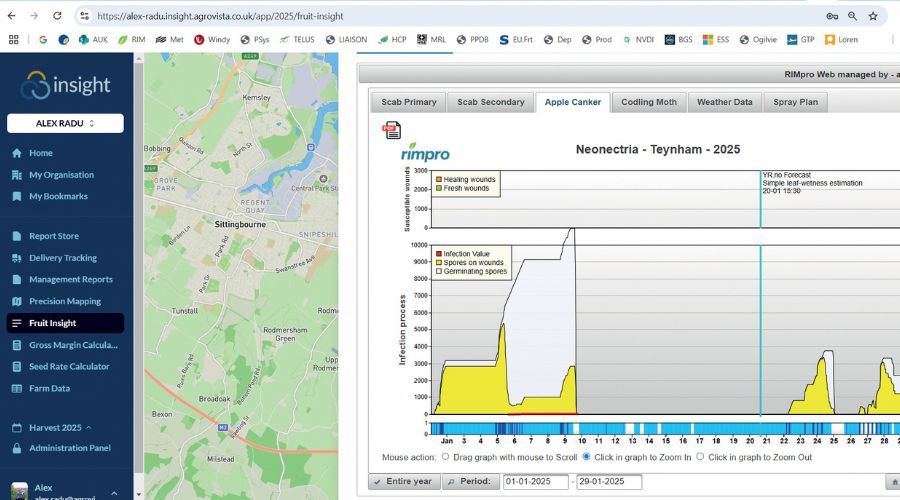Disease management tools: essential aids for optimum crop protection
12th April 2025
Agrovista agronomist Fokion Chatziavgerinos highlights the importance of accurate weather and disease-forecasting tools, and shares his thoughts on early season agronomy.

The weather in the UK has become increasingly unpredictable and unstable.
Apple scab risk increases in wet conditions, with ascospores spread by rain and wind, making it hard for growers to time fungicide applications. Similarly, downy mildew, a major threat to vineyards, thrives when it is warm and rainy.
Given the increasing vagaries of the UK climate, weather stations and disease prediction models are becoming essential tools for apple and vine growers to mitigate the risks posed by top fruit and vine diseases.
Relationship between weather and disease
Integrating real-time weather data with disease forecasting software helps clarify the relationship between weather patterns and disease development, enabling growers to make more informed and timely decisions.
Weather stations in orchards or vineyards collect critical local data, such as temperature, humidity, rainfall, and leaf wetness. This information is vital for understanding the microclimate around the crops and helps predict potential disease outbreaks.
Disease models like those used for apple scab and downy mildew can then be used to predict disease risk, by providing detailed forecasts based on historical weather patterns and real-time environmental factors.
For example, apple scab models predict the magnitude of spore release and infection periods based on temperature and rainfall. Similarly, downy mildew models highlight optimal conditions for infection and the timing of spore germination and release.
Progressive management tool
Agrovista’s Fruit Insight platform is one of the most progressive disease and pest management tools of its kind. It combines real-time weather data with the advanced pest and disease prediction model, RIMpro.
Fruit Insight tracks key threats such as apple scab, codling moth, fireblight, neonectria canker, apple sawfly, downy mildew and powdery mildew, providing insights on pest and disease activity.
Updated every 30 minutes, the app helps growers time their applications for maximum effectiveness, reducing unnecessary treatments and minimising costs. It also allows users to input scab spray programmes, tracking residual coverage and curative activity.
This data-driven approach supports sustainable, efficient management, helping growers to make informed decisions and protect their crops while reducing environmental impact.
Disease management – top fruit
Monitoring for red spider mite eggs and woolly aphid on apple trees early in the season is important to assess the necessity of applying control in the spring.
Gazelle SG approval has come to an end for top fruit, so we will need to adapt and opt for other control options for a number of pests including apple blossom weevil, forest bug, rosy apple aphid amongst others.
Thorough monitoring is required to assess the levels of such pests and intervene when thresholds are reached and/or exceeded. Growers should contact their local Agrovista agronomist to discuss the best control protocols.
Applications for canker and scab control should start promptly at the start of green tip. Product selection will depend on risk and product availability. Spray coverage is of paramount importance, so we recommend using well-formulated and tailored adjuvants such as Velocity, rather than generalist ones, when applying fungicides.
The approval for Syllit 400SC will end on 31st December this year and supply of product ceased at the end of December 2024, so only existing stock on-farm can be used. In conventional orchards we will need to accurately time the applications of scab products and tailor the fungicide programme based on risk.

In pear orchards we need to monitor pear sucker carefully and plan the approach for control in line with the existing pest pressure. We should consider applications of Surround and, when conditions are suitable, the introduction of Koppert Anthocoris predatory bugs.
When trees reach bud-scale separation stage it is important to start assessing the presence of pear weevil using the beating tray as well as by thoroughly examining the buds for damage and egg-laying.
Where threshold is reached in orchards, the findings should be correlated with the daytime temperatures and the number of fruit buds to decide whether treatment is necessary. In mild weather, when daytime temperatures are around 15°C, weevil egg-laying activity is significant and growers should discuss options with their agronomist.
On stone fruit, it is important to bear in mind the risk of canker at the start of the season, during bud burst. Orchard hygiene and management play an important role in managing this problem.
In addition, we recommend well-timed applications of certain foliar feeds and biostimulants, together with suitable adjuvants that improve water quality, coverage and uptake, such as Velocity.
Weed control applications need to be planned before green cluster. Standard glyphosate applications are allowed before green cluster stage (white bud stage on stone fruit). Kyleo is approved for top fruit before green cluster stage.
Starane Hi-Load has good broad-spectrum control of broad-leaved weeds, with good efficacy on nettles. Shield Pro also gives good control of broad-leaved weeds and can be applied with good results where thistles are present.
Disease management – Vines
Growers should aim for good crop hygiene, removing infected plant material from the crop and minimising inoculum carryover. Those who established vines last year should install trellising/supporting systems until June this year.
If trellising is not established during the first year immediately after planting, it can be carried out the following spring when the weather is dry.
Read more fruit news.
